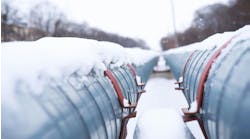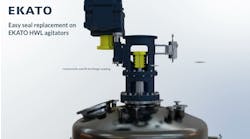Corrosion can have significant impacts on the materials used in chemical processes and industrial equipment. The degradation of materials due to chemical reactions with their environment, typically involving substances like oxygen, water, acids or other corrosive agents, can lead to equipment failure, safety hazards, production downtime and increased maintenance costs.
Over the years, Chemical Processing’s corrosion guru, Greg Borgard, has fielded many questions regarding compatibility and corrosion from readers hoping to avoid headaches caused by adverse chemical reactions. Borgard — senior advisor, engineering — leads the Materials Selection and Compatibility Laboratory at Eli Lilly and Company. He has more than 30 years of industry experience, specializing in material selection issues, conducting compatibility testing and delivering training courses. He holds a Bachelor of Science in chemical engineering from Purdue University and a master's in chemical engineering from the University of Wisconsin-Madison.
Years ago, Chemical Processing asked him how he formulates his answers. He noted, “Oftentimes, an exact and precise answer is not possible, but that doesn’t mean helpful information can’t be passed along.” He also stated the answers are rarely a simple yes or no — they involve different levels of risk and include several considerations that are very context-specific. “As best as I can, I try to include items to think about in my answers that the questioner might not have had in mind when they asked the question.”
Here are a few random questions he’s addressed.
Can you tell me more about aqueous corrosion inhibitors?
Q: We are consuming a molybdate solution inhibitor in a hot water circuit. A while after the molybdate solution was added, tests did not indicate any molybdate in the water, so I suspect that the expiration date has been reached. If molybdate exists in this inhibitor forever, why doesn’t the chemical work after the expiration date?
A: The chemistry of aqueous corrosion inhibitors is complex, and the mechanism by which molybdates inhibit corrosion of ferrous metals is uncertain. According to a paper presented by Susan Rey and Gary Reggiani at the 2005 AWT (Association of Water Technologies) Annual Convention, molybdate is classified as an anodic oxidizing inhibitor and is not effective in the absence of oxygen. It’s believed that molybdate ions react with ferrous ions to form a non-protective ferrous-molybdate complex which, in turn, is oxidized by dissolved oxygen to form an insoluble and protective ferric-molybdate complex in combination with ferric oxide.
It is also hypothesized that molybdate strengthens the outermost hydrated iron oxide layer by hydrogen bonding to hydroxide groups on the surface. This imparts a negative charge on the surface, which "repels" aggressive chloride ions, preventing them from reaching the surface.
Rey and Reggiani say that "from a practical standpoint, the absorbance of molybdate onto the outer hydrated iron oxide layer means that when molybdate is fed to a poorly maintained system containing old corrosion products, molybdate will be consumed, leaving the water treater wondering how it disappeared. Therefore, prior to using a molybdate-based treatment in a fouled system, the system should be cleaned to remove existing corrosion products.
Another implication of the molybdate mechanism is that oxygen must be present, or another oxidant such as nitrite, if a molybdate treatment program is to be most effective."
Perhaps this explains what you are observing in your system. Your best bet might be to contact a third party specializing in water treatment to get advice on your specific system.
What material is suitable for chloric acid?
Q: Would high-density polyethylene (HDPE) piping be adequate for 33% chloric acid (HClO3) service at ambient (~22 C) temperature?
A: When examining questions of material suitability, several factors need to be considered relative to what is meant by suitability. In this instance, 33% chloric acid is a hazardous material that is corrosive to many metals and human tissue and can accelerate or initiate combustion of flammable materials. Thus, a leak or spill of this material could have significant and severe consequences. Our standards of suitability need to be more rigorous for situations that pose elevated risk. Resistance of HDPE to chloric acid is moderate at this temperature and concentration, but much better materials are available that would be more suitable for such a hazardous material. Several of the highly fluorinated plastics provide much better resistance and would be a more robust choice for this application. When better materials are widely available at reasonable costs, sound engineering principles should lead us in the direction of a better design.
Is 316L stainless steel acceptable for aqueous magnesium chloride?
Q: We have an application involving the use of 10% magnesium chloride solution in water, at pH between 6–8, at 15–25 deg C. Can SS 316L resist pitting under these conditions? Is there any threat of any other type of corrosion under these conditions?
A: The references I checked indicate that 316L stainless steel can give acceptable performance for aqueous 10% magnesium chloride under the conditions you listed. However, as you mentioned, there is some risk of localized corrosion, such as pitting (and crevice corrosion). The risk will increase significantly if the pH becomes acidic. If impurities are present, their effect on corrosion resistance should be considered as well.
Is 316 stainless steel pipe compatible with cyanuric acid?
Q: I have been unable to find any data or chemical compatibility for using 316 stainless steel pipe with cyanuric acid. I found a chart that suggests 316 stainless steel is okay to use with cyanic acid, though. Do you know if 316 stainless steel is okay to use to transport cyanuric acid? Operating pressure would be 125 psig, and max temperature would be 100ºF with water added to slurry.
A: I did a quick check, and I couldn't find any compatibility data for cyanuric acid either. The concept of using compatibility data from a surrogate like cyanic acid when one cannot find data for a chemical of interest is sometimes acceptable. The "degree of acceptability" depends on how similar the chemicals are and what degree of risk one can tolerate. In this case, I would probably advise that some laboratory tests be designed and run to generate specific data for the combination of cyanuric acid and 316 stainless steel.
Which is better for a pump: nickel aluminum bronze or stainless steel?
Q: Is nickel aluminum bronze a good pump material if it is exposed to brackish water (2,000–5,000 mg/l chlorides) that has hydrogen sulfide levels of -4 mg/l[AJ1] ? I believe 316L stainless steel is a better material, but please confirm.
A: Your concentration range of chlorides is high enough to be of concern with 316L stainless steel. Generally, the rule of thumb for continuous chloride exposure to 316L stainless steel is 1,000 ppm. The references I checked say that aluminum nickel bronze is acceptable for brackish water and sodium chloride at 70ºF but not for wet hydrogen sulfide gas. However, your hydrogen sulfide levels may be low enough that corrosion won’t be an issue. What alloys might work for your application will depend not only on the chloride and hydrogen sulfide levels but also on temperature and what other species are present. If you can’t find the data to support the selection of an appropriate alloy, lab testing should be considered.
[AJ1]Is this right? -4mg?



